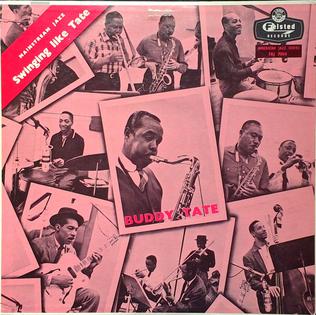
Coleman Randolph Hawkins, nicknamed "Hawk" and sometimes "Bean", was an American jazz tenor saxophonist. One of the first prominent jazz musicians on his instrument, as Joachim E. Berendt explained: "there were some tenor players before him, but the instrument was not an acknowledged jazz horn". Hawkins biographer John Chilton described the prevalent styles of tenor saxophone solos prior to Hawkins as "mooing" and "rubbery belches". Hawkins denied being first and noted his contemporaries Happy Caldwell, Stump Evans, and Prince Robinson, although he was the first to tailor his method of improvisation to the saxophone rather than imitate the techniques of the clarinet. Hawkins' virtuosic, arpeggiated approach to improvisation, with his characteristic rich, emotional, and vibrato-laden tonal style, was the main influence on a generation of tenor players that included Chu Berry, Charlie Barnet, Tex Beneke, Ben Webster, Vido Musso, Herschel Evans, Buddy Tate, and Don Byas, and through them the later tenormen, Arnett Cobb, Illinois Jacquet, Flip Phillips, Ike Quebec, Al Sears, Paul Gonsalves, and Lucky Thompson. While Hawkins became known with swing music during the big band era, he had a role in the development of bebop in the 1940s.
Victor Dickenson was an American jazz trombonist. His career began in the 1920s and continued through musical partnerships with Count Basie (1940–41), Sidney Bechet (1941), and Earl Hines.

The Hawk Flies High is a 1957 album by jazz tenor saxophonist Coleman Hawkins. Apart from Barry Galbraith and Jo Jones on guitar and drums, the line-up of his accompanying sextet had a bebop background, namely J.J. Johnson on trombone, Idrees Sulieman on trumpet, pianist Hank Jones, and Oscar Pettiford on bass.

2-3-4 is an album by American jazz drummer Shelly Manne featuring performances recorded in 1962 for the Impulse! label.

Wrapped Tight is an album by the American jazz saxophonist Coleman Hawkins of performances recorded in 1965 for the Impulse! label.

Bean Bags is an album by vibraphonist Milt Jackson and saxophonist Coleman Hawkins featuring performances recorded in 1958 and released on the Atlantic label.

At Ease with Coleman Hawkins is an album by saxophonist Coleman Hawkins which was recorded in 1960 and released on the Moodsville label.

Night Hawk is an album by saxophonists Coleman Hawkins with Eddie "Lockjaw" Davis, recorded at the end of 1960 and released on the Swingville label.

Swinging Like Tate is an album by saxophonist Buddy Tate which was recorded in 1958 and released on the Felsted label.

Blues a la Mode is an album by saxophonist Budd Johnson which was recorded in 1958 and released on the Felsted label.

Coleman Hawkins and Confrères is an album by saxophonist Coleman Hawkins which was recorded in 1958 and released on the Verve label.

Back in Bean's Bag is an album by saxophonist Coleman Hawkins with trumpeter Clark Terry which was recorded in late 1962 and released on the Columbia label.

The Gilded Hawk is an album by saxophonist Coleman Hawkins with an orchestra arranged and conducted by Glenn Osser which was recorded in late 1956 and early 1957 and released on the Capitol label.

The Hawk in Paris is an album by saxophonist Coleman Hawkins featuring compositions related to Paris performed with an orchestra arranged and conducted by Manny Albam which was recorded in 1956 for the RCA Records subsidiary Vik label.

The Hawk in Hi Fi is an album by saxophonist Coleman Hawkins with an orchestra arranged and conducted by Billy Byers. It was recorded in early 1956 and released on the RCA Victor label.

Accent on Tenor Sax is an album by saxophonist Coleman Hawkins which was recorded in 1955 for the Urania label.

The Hawk Talks is an album by saxophonist Coleman Hawkins compiling tracks recorded between 1952 and 1953 for the Decca label which were first released on LP in 1955.

Disorder at the Border is a live album by saxophonist Coleman Hawkins compiling tracks which were originally broadcast in 1952 and first released on LP in 1973 on the UK Spotlite label.

The Saxophone Section, is an album by saxophonist Coleman Hawkins which was recorded in 1958 and released on the World Wide label.

Jazz Reunion is an album by saxophonist Coleman Hawkins and clarinetist Pee Wee Russell which was recorded in 1961 and released on the Candid label.



















